The global NPK (nitrogen-phosphorus-potassium) fertilizers market is projected to grow from approximately USD 3.32 billion in 2025 to USD 4.87 billion by 2035, representing a compound annual growth rate (CAGR) of 3.9%. The steady rise will be supported by ongoing demand in agriculture, driven by global efforts to enhance crop yield and soil health in response to population growth and environmental needs.
In recent developments, a surge in interest in nano-fertilizers has been observed. A notable case emerged in 2025 from IFFCO, whose sales of nano-fertilizers jumped 47% year-over-year, reaching 365 lakh bottles sold in 2024-2025. This growth underscores a growing awareness of precision nutrient applications and environmentally sustainable farming methods across key markets, such as India.
Research published in 2025 in Nature Reviews Journal pointed to emerging enhanced-efficiency fertilizers, such as nano-encapsulated NPK formulations that deliver nutrients in a controlled, crop-responsive manner. These technologies offer improved nutrient uptake and reduce runoff, aligning with global efforts to decrease agricultural environmental impacts.
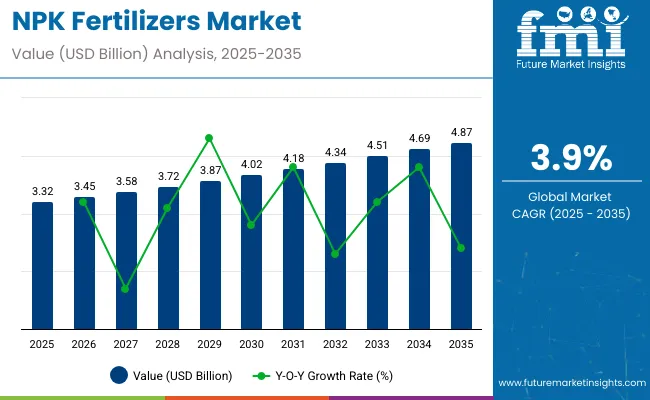
| Attributes | Description |
|---|---|
| Estimated NPK Fertilizers Market Size (2025E) | USD 3.32 Billion |
| Projected NPK Fertilizers Market Value (2035F) | USD 4.87 Billion |
| Value-based CAGR (2025 to 2035) | 3.90% |
Moreover, controlled-release NPK blends, incorporating biodegradable coatings and urea stabilizers, are gaining regulatory approvals in Europe and North America. These products respond to demand shifts from farmers and regulators for fertilizers that improve nitrogen use efficiency and lower greenhouse gas emissions in cropping systems.
Regionally, North America maintains a significant share, driven by its strong agricultural infrastructure and supportive policies for sustainable nutrient management. Europe follows closely, propelled by the Common Agricultural Policy’s emphasis on precision fertilizer use. However, Asia Pacific is expected to experience the fastest growth. This is due to rapid agricultural expansion, government-supported adoption of advanced fertilizer technologies, and a growing focus on yield improvements in countries such as China and India.
Overall, as advances in slow-release, nano-formulated, and controlled-release fertilizers gain regulatory acceptance and reach commercialization, the NPK fertilizers market is set for gradual yet sustained growth through 2035. These innovations are increasingly favored for boosting yield, reducing environmental impact, and enabling efficient nutrient management performance profile that aligns well with evolving agricultural needs and global sustainability goals
Per capita spending on NPK (Nitrogen, Phosphorus, Potassium) fertilizers varies widely across regions based on agricultural intensity, crop types, government subsidies, and farming practices. The level of investment in balanced fertilization reflects a country's approach to crop productivity and soil health.
The global trade of NPK fertilizers is shaped by regional disparities in raw material availability, domestic production capacity, and agricultural demand. Countries with strong fertilizer manufacturing infrastructure and access to key inputs like potash, phosphate rock, and natural gas dominate exports, while import-heavy regions rely on international suppliers to meet their growing crop nutrition needs.
The table below presents a comparative assessment of the variation in CAGR over six months for the base year (2024) and current year (2025) for the Global NPK fertilizer industry.
This analysis reveals crucial shifts in industry performance and indicates revenue realization patterns, thus providing stakeholders with a better vision of the ecosystem growth trajectory over the year. The first half of the year, or H1, spans from January to June. The second half, H2, includes the months from July to December.
| Particular | Value CAGR |
|---|---|
| H1 | 3.3% (2024 to 2034) |
| H2 | 4.1% (2024 to 2034) |
| H1 | 3.5% (2025 to 2035) |
| H2 | 4.6% (2025 to 2035) |
The above table presents the expected CAGR for the Global NPK fertilizer industry over several semi-annual periods spanning from 2024 to 2034. In the first half (H1) of the decade from 2025 to 2035, the business is predicted to surge at a CAGR of 3.3%, followed by a slightly variable growth rate of 4.1% in the second half (H2) of the same decade.
Moving into the subsequent period, from H1 2025 to H2 2035, the CAGR is projected to change slightly to 3.5% in the first half and remain relatively moderate at 4.6% in the second half.
The NPK fertilizers industry is expanding globally as demand for balanced crop nutrition rises. In 2025, phosphorus-based fertilizers will dominate with a 41% market share, driven by their role in root development and energy transfer. Additionally, powdered fertilizers will account for 62% of total sales, due to their easy storage, transport, and application advantages.
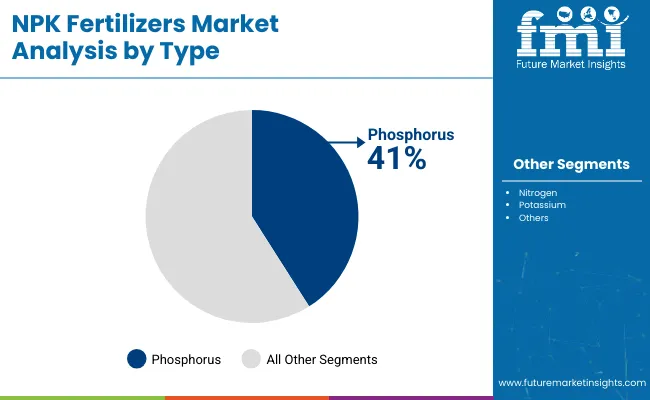
Phosphorus-based fertilizers are expected to account for 41% of the total NPK fertilizers market in 2025. Their critical role in promoting root development, enhancing energy transfer within plants, and improving flowering and fruiting drives this demand. Crops such as corn, wheat, rice, and legumes benefit significantly from phosphorus application. As global emphasis on yield optimization and sustainable agriculture grows, farmers increasingly adopt phosphorus-based NPK blends.
Leading fertilizer producers including Yara International ASA, EuroChem Group AG, The Mosaic Company, and Nutrien Ltd. invest heavily in innovative phosphorus formulations. Enhanced efficiency products-such as slow-release phosphorus and phosphorus with micronutrient additives-are gaining traction, reducing runoff and improving nutrient uptake.
Additionally, government-supported initiatives across Asia-Pacific and Africa encourage phosphorus use to improve soil health in nutrient-deficient regions. As precision farming advances, customized NPK blends rich in phosphorus will remain essential to optimizing crop performance through 2025.
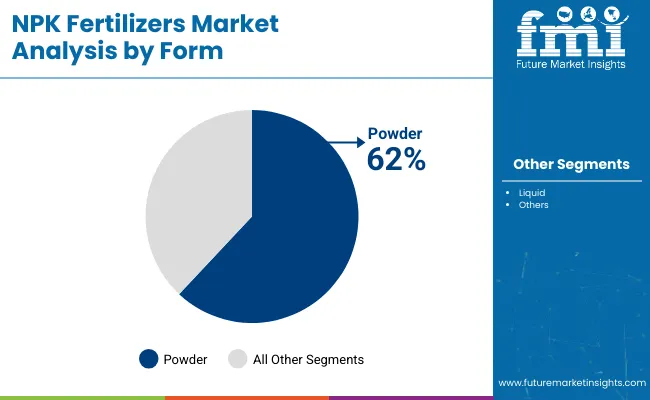
Powdered NPK fertilizers are projected to hold a dominant 62% market share by form in 2025. Their ease of storage, cost-effective transport, and simple application make them the preferred choice among large-scale growers and agricultural cooperatives. Powdered fertilizers offer uniform nutrient distribution and compatibility with various soil types, enhancing their appeal across diverse geographies. They are especially favored in mechanized farming systems, where precision in fertilizer application is crucial.
Top players such as ICL Group, PhosAgro, Haifa Group, and Compo Expert continue to innovate in powdered formulations. Products with enhanced solubility, dust control coatings, and bio-stimulant integrations are driving adoption. Powdered NPK fertilizers also align well with precision agriculture technologies, enabling variable-rate application through automated spreaders. This compatibility with modern farming practices further strengthens their market position.
To safeguard the health and maximize the productivity of livestock, the dairy industry attaches great importance to superior quality animal feed. The requirements for high-quality feeds in dairy farming translate into the need for fertilizer crops, hence the rising sales of NPK fertilizers.
To improve the economic inputs in dairy farming, farmers are using these fertilizers to increase the quality of forage crops such as alfalfa and corn which are crucial in dairy cattle diets. NPK fertilizers contribute to increased quantities and quality of crops, which in turn help satisfy the ever-increasing market for dairy products while ensuring that the animals are well-fed.
NPK fertilizers' market depends on precision agriculture, which allows farmers to minimize fertilizer and maximize its effect. Precision farming techniques include the use of accurate GPS, soil sensors and data analytics to monitor the variable nutrient requirements of the crops thereby reducing wastage.
This tendency encourages the formulation of a wider range of NPKs as per the technical requirements of different crops and soil fertility situations in order to improve productivity and sustainability.
The adoption of digital farming solutions is a major trend in the NPK fertilizers industry. Such solutions entail the use of programs and other applications to schedule fertilization, assess the condition of crops, and interpret soil parameters.
It becomes possible for farmers to reduce the levels of waste and increase productivity through the application of fertilizers. This trend is improving the efficiency as well as the effectiveness of NPK fertilizers and thus increasing their availability to farmers in different countries.
Global sales increased at a CAGR of 5.5% from 2020 to 2024. For the next ten years (2025 to 2035), projections are that expenditure on the industry will rise at 3.9% forecast CAGR.
The NPK fertilizers market has been steadily growing on a global scale over the past few decades. The population boom led to increased demand for food and hence, the agriculture industry had to respond positively with increased productivity.
In terms of the past evolution of the industry, great improvements have been recorded in fertilizer parameters, level of nutrients and crop yields. There have been improvements in NPK fertilizers due to new technologies targeted at the production and use of precision farming. Key players began the globalization of their activities by creating robust supply systems and distribution systems to satisfy the increasing demand.
In the long run, the NPK fertilizers industry is likely to continue the trend of growth, especially in the areas of sustainability and environmental considerations. Shortly, it is expected that environmentally friendly fertilizers will be invented that do not lead to nutrient loss and also help in reducing emissions.
High investment in research and development is expected to be directed towards the development of complex formulations that will be tailored to the needs of certain crops and soils. Moreover, the application of digital tools in smart farming will also improve the efficiency of fertilizer use through improved data management. Given the fact that food security is a global issue, the NPK fertilizers industry will always remain relevant in the sustainable practices of agriculture and nutritional issues of the growing population.
NPK fertilizers market appears both fragmented and consolidated, depending on the region and market segment. At the world stage, it can be observed that the industry is mostly consolidated with market trends being governed by a few large multinational corporations (MNCs).
Some of these MNCs include Yara International ASA, Nutrien Ltd and Mosaic Company, and they have huge market shares with vast distributing companies as well as R&D capacities. This presence creates a healthy environment for competition as well as innovation which pushes the industry on efficient and greener pathways.
On the other hand, within specific regions, the industry is more fragmented, such as in the case of less developed economies. In this case, several small and medium-sized enterprises (SMEs) provide services to the local demand. Many of these regional firms apply selective cropping strategies or any particular local soil ability that can be overlooked by MNCs.
For instance, Coromandel International in India and Haifa Group in Israel are examples of this as they are big regional business companies with a great deal of control in the local markets.
In a concentrated industry structure, only a few producers dominate the industry leading to structural efficiency in the industry. On the contrary, in a fragmented market, numerous smallholders have a slight stake in the industry and therefore, hardly any singular market entity is in a position to dominate control over the industry.
FMI assessment indicates that most of the global activities in the manufacture of NPK fertilizers are dominated by multi-national corporations. However, when it comes to regional markets, the picture is a little different as countless small-scale local players exist within the industry. This combination ensures that for every threat and opportunity in the cultivated agricultural market, there is room for either global or local response or strategy if necessary.
SKW Stickstoffwerke Piesteritz provides high-quality NPK fertilizers with concern for green and climate-friendly production. There is cooperation with STX Group for the improvement of de-fossilized, urea-based fertilizers production. Their future outlook includes increasing the share of biomethane in production in order to satisfy the growing demand for sustainable fertilizers.
PetChem Holdings has a wide range of NPK fertilizers for different kinds of crops, improving nutrient absorption capability and crop yield. They are putting resources in R&D to come up with new designs of slow or neutral fertilizers. Their growth strategy encompasses increasing their market share through high technology and eco-friendly farming methods.
Yara International ASA's main source of revenue remains the production of NPK fertilizers while also pursuing the objectives of decarbonization and sustainable nutrition of crops. There is an aggressive rollout of fertilizers made with green ammonia as they increase their organic and biostimulant product range. In the future, Yara intends to focus on the development of markets in low-carbon ammonia and premium fertilizers.
The following table shows the estimated growth rates of the top five markets. These countries are set to exhibit high consumption, recording high CAGRs through 2035.
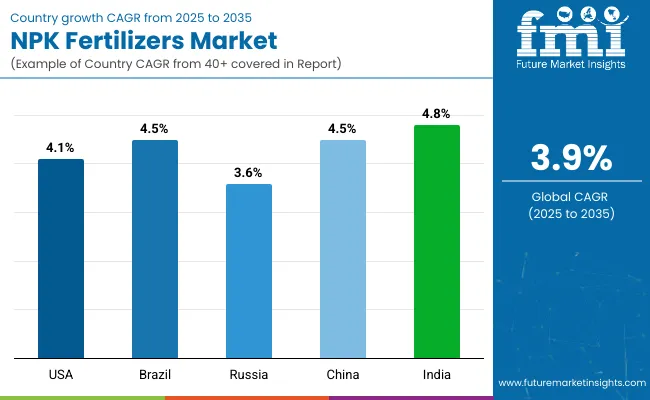
| Countries | CAGR 2025 to 2035 |
|---|---|
| USA | 4.1% |
| Brazil | 4.5% |
| Russia | 3.6% |
| China | 4.5% |
| India | 4.8% |
Agricultural modernization in China is leading to increased NPK fertilizer sales in the country. The state has put forth a number of approaches designed to improve agricultural productivity and increase food security in the populous nation. Such measures include the introduction of modern crop management technologies, precision farming and balanced fertilization. Food self-sufficiency, improving soil conditions and yields by using advanced farming practices are enabling China to import less.
This includes a duty on the usage of sustainable farming technologies and high performing fertilizers, which the strategy enhances, which then creates higher demand for NPK fertilizers in the region. The industry for NPK Fertilizers in China is projected to exhibit a CAGR of 4.5% during the assessment period and revenue from the sales of NPK Fertilizers in the country is expected to reach USD 1,185.7 million with a market share of 25%.
In India, government initiatives are the driving factors of NPK fertilizers demand. Programs such as fertilizer subsidies, introduction of soil health cards and promotion of balanced nutrient management have been started to increase agricultural productivity. The increase in use of NPK fertilizers to increase crop yields and soil fertility addresses the problems of food security and rural development.
Further, there is the government's desire to increase the income of farmers as well as promote sustainable agriculture. Hence, demand for NPK fertilizers is on the rise as a support of the agricultural sector in India. These trends are leading to a projected value of USD 927.9 million by 2035 with NPK Fertilizers demand calculated to rise at a value CAGR of 4.8% during the forecast period (2025 to 2035) with a value share of 20%.
In Brazil, NPK fertilizers have an increased demand due to the fact that agriculture is an export business. Due to Brazil occupying the position of the world leader as a soybean, corn, sugarcane and coffee exporter, there is intensive use of high-performing fertilizers to sustain current and increase future harvests. Since the country has vast amounts of land that are agriculturally productive as well as good climatic conditions, they are largely regarded as leading players in the food production chain internationally.
Because of rising international demand for its agricultural products, Brazil seeks to modernize its farming techniques, which includes efficient in NPK management. These factors are responsible for the robust projected forecast CAGR of 4.5% from 2025 to 2035, with the country achieving a global value share of 14% in 2035 with a value of USD 674.9 million.
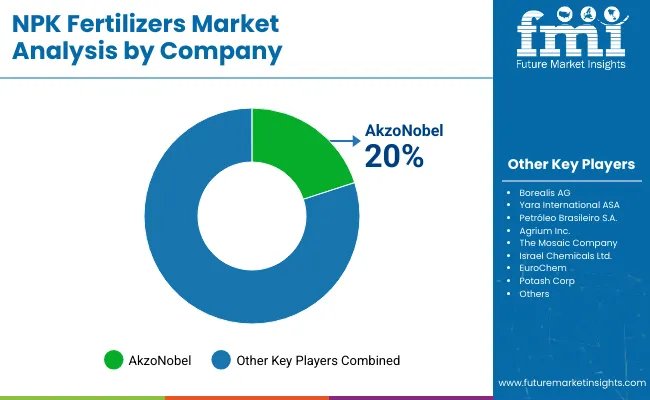
The world of NPK fertilizers market is very dynamic as every company in the industry is trying to gain value share through acquiring and merging with other companies. These maneuvers are designed for firms in order to increase their market footprint and to add new products to their existing ones. Current observation has shown an increase in partnerships that seek to use advanced technologies to come up with more effective and eco-friendly methods of producing fertilizers.
New product introduction is also a priority with firms adopting technological advancements in creating solutions that address the needs of the crops and the surrounding environment. This not only assists in fulfilling the increasing needs of high-yield crop production but also tackles some issues of sustainability.
Additionally, companies are also implementing smart agriculture solutions to help farmers apply fertilizer more accurately and increase agricultural productivity as a result. Thus, partnerships have been established with local distributors and farmers' cooperatives in order to improve product distribution channels and ensure product availability in the industries.
| Report Attributes | Details |
|---|---|
| Market Size (2025) | USD 3.32 Billion |
| Projected Market Size (2035) | USD 4.87 Billion |
| CAGR (2025 to 2035) | 3.9% |
| Base Year for Estimation | 2024 |
| Historical Period | 2020 to 2024 |
| Projections Period | 2025 to 2035 |
| Quantitative Units | USD billion for value and million metric tons for volume |
| Types Analyzed (Segment 1) | Nitrogen, Phosphorus, Potassium, Others |
| Forms Analyzed (Segment 2) | Powder, Liquid, Others |
| Applications Analyzed (Segment 3) | Bakery Products, Meat & Meat Products, Dairy Products, Beverages |
| Regions Covered | North America; Latin America; Western Europe; Eastern Europe; Balkans & Baltic; Russia & Belarus; Central Asia; East Asia; South Asia & Pacific; Middle East & Africa |
| Countries Covered | United States, Canada, Brazil, Mexico, Germany, France, United Kingdom, Italy, Spain, China, India, Japan, South Korea, Australia, GCC Countries, South Africa, Russia, Belarus |
| Key Players influencing the NPK Fertilizers Market | Yara International, EuroChem Group, Nutrien Ltd., PhosAgro, The Mosaic Company, ICL Group (Israel Chemicals Ltd.), CF Industries, Haifa Group, IFFCO (Indian Farmers Fertiliser Cooperative Limited), BASF SE |
| Additional Attributes | Market size in dollar sales and CAGR, share by nutrient ratio (NPK grades), crop-wise demand trends, regional dollar sales, raw material pricing impact, competitive landscape and dollar sales, regulatory shifts, emerging markets, distribution channel trends. |
As per Type, the industry has been categorized into Nitrogen, Phosphorus, Potassium and Others.
As per Form, the industry has been categorized into Powder, Liquid and Others.
As per Application, the industry has been categorized into Bakery Products, Meat & Meat Products, Dairy Products and Beverages.
Industry analysis has been carried out in key countries of North America, Latin America, Western Europe Eastern Europe, Balkans & Baltic, Russia & Belarus, Central Asia, East Asia, South Asia & Pacific, and Middle East & Africa.
The global market is estimated at a value of USD 3.32 billion in 2025.
Prominent players in the landscape include SKW Stickstoffwerke Piesteritz, Borealis AG, AkzoNobel, Yara International ASA, Petróleo Brasileiro SA, Agrium Inc and The Mosaic Company.
The Global Industry grew at a Historical CAGR of 5.5% from 2020 to 2024.
The USA sales are projected to hold a revenue share of 30.7% over the forecast period.
The industry is projected to grow at a forecast CAGR of 3.9% from 2025 to 2035.






Full Research Suite comprises of:
Market outlook & trends analysis
Interviews & case studies
Strategic recommendations
Vendor profiles & capabilities analysis
5-year forecasts
8 regions and 60+ country-level data splits
Market segment data splits
12 months of continuous data updates
DELIVERED AS:
PDF EXCEL ONLINE
Biofertilizers Market Size and Share Forecast Outlook 2025 to 2035
Nano Fertilizers Market Size and Share Forecast Outlook 2025 to 2035
Starter Fertilizers Market Size and Share Forecast Outlook 2025 to 2035
Specialty Fertilizers Market Size and Share Forecast Outlook 2025 to 2035
Microalgae in Fertilizers Market Analysis - Size, Share, and Forecast 2025 to 2035
Water Soluble Fertilizers Market Trends 2025 to 2035
Controlled & Slow Release Fertilizers Market 2025-2035

Thank you!
You will receive an email from our Business Development Manager. Please be sure to check your SPAM/JUNK folder too.
Chat With
MaRIA